NASA's Stardust Mission: Returning Comet Samples to Earth
By Dr. Donald Brownlee
Stardust Principal Investigator
Why Explore Comets?
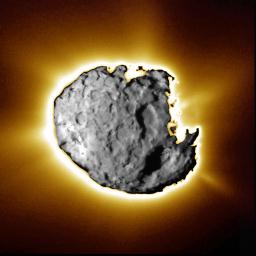
An artificially colored composite of an image of the
nucleus of comet Wild2 superimposed on a longer exposure image
of the jets of materials leaving the comet.
|
Over a lifetime, most people are fortunate enough to see at
least a few bright comets grace the night sky. The bright ones,
along with their more numerous faint siblings, are mysterious
travelers from the frigid and most distant parts of the solar
system. When a comet approaches the sun, its surface warms
and it dramatically becomes brighter. To an observer on Earth,
a bright comet may be seen over a period of weeks or months.
It drifts across the constellations, gets brighter from night
to night and then slowly fades to invisibility after rounding
the sun and heading back into to the depths of space. Over
the past half century, Hale-Bopp, West, Hyakutake, Ikeya-Seki
and Bennett have all been bright comets that could be easily
seen with the naked eye, sometimes even by observers looking
into the brightly lit skies of modern cities. With the unaided
eye, we see comets as objects with a hazy head and one or two
nebulous tails stretching away from the Sun. Only rare comets
are truly bright and most appear as mere ghostly visitors, clearly
out of place among the familiar sky of stars and planets.
It is ironic that comets are rarely seen because they are actually
the most abundant bodies that orbit the sun. They only seem
to be rare because we usually only see them when they are in
the inner solar system and close to Earth. Over a trillion of
them are believed to exist in two distant regions. One region
is called the Kuiper Belt, a flattened annular ring just beyond
the planet Neptune, and the other is the Oort Cloud, a spherical
cloud that extends outwards to a distance roughly 50,000 times
larger than distance between the Earth and the Sun. Although
these bodies are usually far away they still orbit the sun.
An additional irony of comets is that the ones that that come
into the inner solar system and become bright and active, are
actually near the ends of their long lives as solar system bodies.
Even if they survive the rigors of being heated near the sun,
they are exposed to gravitational encounters with planets that
cause them to be ejected from the solar system. They are ejected
and become frigid relics drifting among the stars for a very
very long time. Even after the Sun has burned itself out, billions
of years from now, vast numbers of our ejected comets will still
be wandering our Milky Way Galaxy. Even when all of the stars
of the Milky Way have finally burned out, these bodies will
still be there wandering the darkness of space.
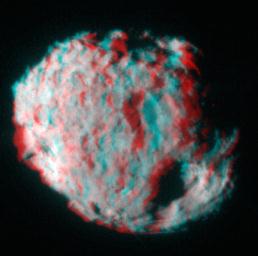
Stereo image of the comet taken near the closest approach.
To view the 4.5 kilometer diameter comet in stereo, use red
and blue (or red and magneta) glasses with blue covering the
right eye.
|
In Greek and Roman times, comets were known as "hairy stars".
Images taken with modern telescopes show them to be spectacular
with a head (called the coma) up to ten times the diameter of
Earth and complex tails that sometimes stretch away from the
Sun for more than 150 million kilometers, the distance between
the Earth and the Sun. The coma and tails are composed by gas
and dust that was liberated from the comet by solar heating.
The activity of comets that produces the coma and tail, usually
increases dramatically as they enter the inner regions of the
solar system and their surfaces are baked by the intense heat
of the sun. Far from the Sun, comets are just cold inactive
bodies. As they approach the sun, their interiors stay cold
but their black-as-coal surfaces become quite hot. At the Earth's
distance from the sun, you would burn your hand it you touched
the sun-facing side of a comet. Solar heating causes water
ice and less abundant frozen volatiles such as methanol and
carbon monoxide to vaporize and the liberated gas molecules
stream outwards from the surface at near supersonic speed. Dust
and rocks that were glued together by ice are released and driven
outwards by the wind of escaping gas. The rocks and dust travel
at low to moderate speeds but the gas soon becomes electrically
charged and is blown away from the Sun by the solar wind at
speeds of about 0.1% of the speed of light. The gas and dust
tails point in somewhat different directions because of the
physics that drives them. The gas blows in the direction that
it is pushed by the solar wind, and the dust and rocks move
in a path controlled by the Sun's gravity and the pressure
of its light.
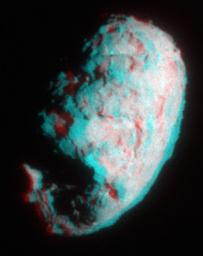
A stereo view of the west edge of comet as the spacecraft
was on approach. The large depression near the bottom is Shoemaker
Basin.
|
As beautiful as they are, when you usually see a comet you
are not actually seeing it. The tails and coma are not the
comet at all, they are what is what is produced when a comet
is in the process of being destroyed by the heat of the Sun.
An active comet loses tons of matter each second and the escaping
debris is what is seen, not the comet itself. Typical comets
are small irregular black bodies of rock and ice only a few
kilometers across. Even if you have a telescope large enough
to detect light directly reflected from the comet's surface,
you usually cannot see it because of its enshrouding smog-like
coma. Bright comets are bright because of the fluorescence
of their escaping gas and sunlight reflecting off escaping dust.
When you observe a comet it is somewhat like driving home and
seeing your house, unexpectedly from a great distance, because
it is on fire and producing great clouds of smoke. When a house
burns or a comet produces dust, the total surface area of the
smoke or dust is much larger than that of the body that produced
it and therefore is much easer to see from a distance. This
"amplification effect" is a result of the fact that small
particles have large surface areas in comparison to their mass.
Comets are wonderful solar system objects but much of their
physical makeup remains a mystery. They contain near-surface
ice and volatiles that sublime to gaseous state when close to
the Sun. This process also liberates vast numbers of solid materials
ranging in size from dust much too small to see with the naked
eye to boulder-sized objects. Comets are beautiful and they
are mysterious but they are also of extraordinary scientific
value. They are cold bodies that formed near the outer edge
of the solar system. Some comets are so volatile that they begin
to evaporate near the orbit of Saturn (ten times further from
the Sun than we are). These primitive bodies have been largely
preserved at very low temperatures. At the very minimum, they
contain regions that have not been heated above cryogenic temperatures
since the formation of the sun and planets 4.5 billion years
ago.
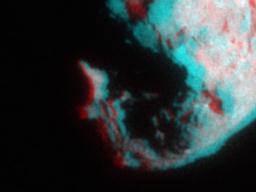
Stereo close-up of Shoemaker basin with a large pinnacle
rising from its center. The Sun is on the right and the column-like
pinnacle casts its shadow on the wall on the left. Mesas, flat
topped hills surrounded by clifts, can be seen on both the left
and right sides of the picture.
|
It is widely believed that comets are the best bodies for preserving
the very materials that the solar system was built from. Like
a fantastic library, they have stored preserved materials and
records of our formation. The gaseous emissions can be analyzed
from a distance either by telescopes on or orbiting Earth or
by instruments on spacecraft sent to comets. The dust and rocks
are another matter. They are believed to be samples of the
solid building blocks of the solar system, samples of the solids
that began the process of collision and sticking in the early
history of the solar system that began with dust and produced
ever larger bodies, and ultimately whole solid planets like
Earth, Mars and Pluto. Some information can be obtained by
telescopic study of the dust but the real secrets of the material
cannot be examined remotely. On scales from kilometers to
microns (a hair is about 100 microns in diameter) primitive
materials just look like black charcoal. They are black due
to their high content of carbon and other light absorbing materials
and most of their components are so small that they cannot be
individually seen by the naked eye. Like books in a library,
they have to be opened and read but in this case the words are
small, very small. So small they can only be read by large
microscopes and other instruments that are too heavy, complex
and power hungry to be put onto robotic spacecraft.
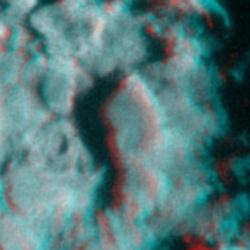
Stereo view of the flat-floored depression called "left
foot". The cliffs are 140 meters high.
|
The fine dust and rocks in comets are best studied on Earth
where complex instruments can be used to fully study the materials
at scales approaching atomic spatial resolution. The need for
laboratory study of samples from the Solar System's most primitive
bodies, was the inspiration for the NASA Stardust mission, the
first NASA mission to return samples from space since the Apollo
17 Lunar mission in 1972. Stardust was launched in 1999 with
the goal of flying past the comet Wild 2, collecting thousands
of dust particles and returning them to Earth. After return,
the samples will be studied, in intimate detail, by researchers
around the world using the most sensitive and accurate instruments
in existence. The samples will be studied to learn about the
fundamental nature of interstellar grains (stardust) and other
solid materials that assembled to form the solar system 4.6
billion years ago.
The particles are collected by impact into an exotic glass
called aerogel. Like sand it is composed of silicon dioxide
but unlike other solid materials, it is extremely lightweight.
Although it is a solid that can be held in your hand, its density
is more similar to air than to normal solid material. During
the comet flyby, comet dust hits the crystal-clear aerogel and
imbeds deep inside forming tracks shaped like carrots with the
captured particle located at the tip. Aerogel is the lowest
density solid that has ever been made and one of its nicknames
is "frozen smoke".
Encountering a Comet
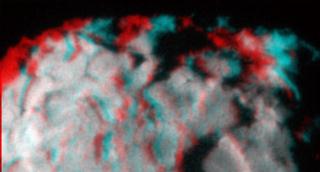
Stereo view of Rahe, a feature that is believed to
be an impact crater.
|
On January 2, 2004, after five years in space and billions of
kilometers of travel, Stardust finally reached its target for
a brief but daring encounter. The spacecraft flew within 236
km of the comet Wild 2 and survived the high speed impact of
millions of dust particles and small rocks up to nearly half
a centimeter across. With its tennis racket shaped collector
extended, Stardust captured thousands of comet particles that
will be returned to Earth on January 15, 2006.
In addition to collecting samples, Stardust also took pictures
during its flyby. The images were startling because they showed
a surface that is unlike anything previously seen in space.
The camera's mirror tracked the comet during the flyby enabling
the camera to take images over a full range of angles. The
4.5 km comet is shaped like a hamburger and the approach and
exit images provided edge-on views. Near the closest approach,
the broadest face of the comet was seen. The long exposure
images showed sunlight reflecting off jets of dust projecting
into space. We were expecting one or two jets but we saw 20.
Jets are produced when gas escapes from localized regions and
carries dust and rocks outwards. The low-density gas is invisible
but the entrained dust scatters sunlight making it visible.
The large number of jets shows that gas sources on Wild2 are
numerous and probably small. Dust detectors on the spacecraft
measured bursts of impacts when Stardust flew through jets.
The camera also took short exposure images that were ideal
for imaging features on the comet's surface. Before Stardust,
only spacecraft had imaged the surfaces of two comets, Halley
and Borrelly. Both of these comets had elongated shapes, similar
to peanuts, and their surface features were relatively subtle.
Unlike the previous comets, Wild 2 was seen to have a slightly
flatten shape and its surface was covered with dramatic features.
The very first image that was downloaded showed two spectacular
depressions, a kilometer across, with steep walls and flat floors.
These large depressions resemble sinkholes seen on Earth but
their origin is still a mystery. They might be impact craters,
they might have formed because of internal processes or they
may have formed by surface processes related to the volatilization
of ice.
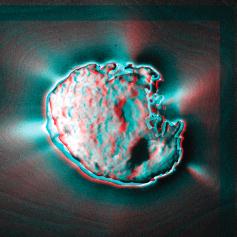
Stereo view of the comet and its jets. Note that two
of the jets on the right come from the comet's dark side.
|
There were two expectations about the nature of the comet's
surface. If the surface was billions of years old we expected
to see a cratered surface like that of the Moon and asteroids.
If the surface was young, the old surface removed by vaporization
and solar heating effects, we expected to see a smooth, somewhat
featureless surface. One thought was that a young surface on
an active comet would be smooth because valleys and hills would
be covered by "fall-back material" that had been ejected
skyward but then fell back. Old or new, its was also anticipated
the comet's surface would be composed of a "rubble pile"
of fine sand-like debris loosely held together. What we saw
was a very rough surface that was not made of loose material.
It has strength and some areas have vertical cliffs and even
overhangs. We also saw that much of the comet's surface is
covered with depressions. We believe that some of the depressions
are impact craters but they are unusual and not a single depression,
anywhere on the comet, is similar to typical impact craters
seen on the Moon, Mars, satellites and asteroids. Normal impact
craters on solar system bodies are bowl-shaped depression surrounded
with raised rims. One of the comets features called Rahe, does
appear to be an impact crater and it has a bowl-shaped central
pit but it is oddly surrounded by a very jagged halo that appears
to have been blasted off the comet. This morphology has never
been seen or other bodies for such large craters. Other crater-like
depressions have flat floors lined with vertical cliffs and
some have oddly non-circular shapes.
A major surprise was the observation of ridges, mesas (flat
toped hills bounded by cliffs) and pinnacles rising more than
100 meters above their surroundings. It is likely that these
features are remnants left after the loss of more than 100 meters
of original surface. The pinnacles are column-like features
that have never been observed on other solar system bodies,
other than Earth.
The flyby was a great success not only in collecting particles
from a dangerous environment but also in providing a wealth
of information on the comet and its evolution during its long
history of travel in the solar system. The remarkable surface
of this body is the result of billions of years of residence
beyond the orbit of Neptune and a brief recent history inside
the orbit of Jupiter.
The sampled comet formed near Pluto at the very edge of the
solar system, and it only recently entered the inner solar system
where it could be approached for sampling. Comets like Wild
2 are a special interest to astrobiology because they are preserved
samples of the fundamental building blocks of the solar system.
All planetary systems are likely to also contain cometary bodies
composed of ice, organics and rock. For planets like Earth,
which formed close enough to a star to be in its warm habitable
zone, comets provide a source of organic material and water
that continually impact from distant regions of the planetary
system. Most of the atoms in our planet and our bodies were
at one time contained in particles of the type that are released
by comet Wild 2. As stated in a famous song, quite literally
"we are stardust".
The Stardust spacecraft is now speeding home and its sample
return capsule will land in the desert near Salt Lake City Utah
in the early morning of January 15, 2006.
Last updated November 14, 2005
|
|
